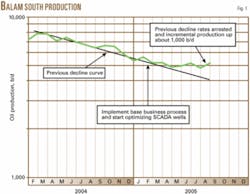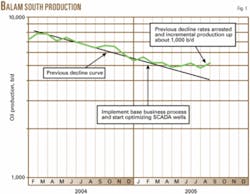Resizing pumps, installing rod-pump controllers (RPCs), and monitoring and analyzing wells remotely with software specific for that purpose increased operational efficiency in Balam South field on Sumatra Island, Indonesia.
PT Chevron Pacific Indonesia operates the field.
The company’s optimization program involved phased installation of state-of-the-art technology. The wells highest on the prioritized list were determined to be more likely to provide the most return for the investment in automation.
The results were better than expected with several wells increasing production by about 200 bo/d. The wells also had lower electrical and repair costs.
Initial phase
Balam South field has about 220 wells with 95 of the wells having a rod pump. Average well depth is 1,000 ft. The produced oil has a 28-30° gravity and the wells produce with an average 85% water cut.
Before implementation of this program, the wells had no automation or control systems installed. Many of the pumps ran 24 hr/day without pumping off the well. These wells would benefit from merely an increase in pump size; however, an increase in the pumping capacity could cause the wells to pump off and subject the pumps to excessive wear.
To minimize the number of strokes after pumping off the well, the company installed RPCs from eProduction Solutions (eP). A controller allows the well to pump down to a minimal fluid level and stops the pump when fluid pound occurs.
The controller ensures that the pump shuts off at the appropriate time and calculates the appropriate idle time from the changing run times. A desktop analysis program, eP’s csBeam, optimizes run times and pump-off points.
The software provides up-to-date surface dynamometer cards, downhole cards, runtime statistics, and trends of well parameters. With this information, the well analyst fine-tunes the controller to optimize production.
Results
Implementation of this program increased production, decreased repair costs, and lowered electrical costs. Several factors provided these benefits.
Lower fluid levels in a well decreases backpressure on the reservoir and consequently increases production. Additionally, reduction in downtime lowered repairs and ensured more pumping time and ultimately, more produced fluid.
Four wells that pumped off increased oil production by about 200 bo/d/well.
Pumping the wells less than 24 hr reduces average run time with no loss in oil production. The pumps only run when the barrel is full of fluid, about 5-10 min. This increases pump run life by avoiding accelerated wear from fluid pounding the pump.
In the long-term, this will reduce downtime associated with pump repair, thus reducing repair costs.
The work has arrested the field’s production decline (Fig. 1) and the field still has more wells to optimize.
The company continues to prioritize target wells, execute the optimization plan, and ensures that return on investment is weighted early in the project. This provides an early payout for the project.
The combination of well design, hardware at the wellsite, analysis software at the desktop, training of the well analysts, and corporate commitment to implement the program benefited field profitability in both the short and long-term.
The company also has other rod pumped fields in Sumatra that could benefit from this type of automation.
The authors
Faried Efendi works as a petroleum engineer for PT Chevron Pacific Indonesia in Duri-Riau, Indonesia. His work involves reliability optimization of artificial lift and SCADA systems. Efendi holds a BS in petroleum engineering from Bandung Institute of Technology and an MS in petroleum engineering from the University of Tulsa.
Kurza Mulyadi is an operations engineer for PT Chevron Pacific Indonesia in Duri-Riau, Indonesia. His work involves reliability optimization of artificial lift and SCADA systems. Mulyadi has a BS in petroleum engineering from Universitas Pembangaun Nasional, Yogyakarta, Indonesia.
Emir Syahrir is project manager for eProduction Solution-PT Catur Khita Persada in Jakarta. His work involves reliability optimization of artificial lift and SCADA systems. Syahrir has a BS in civil and architectural engineering from the University of Trisakti, Jakarta.




